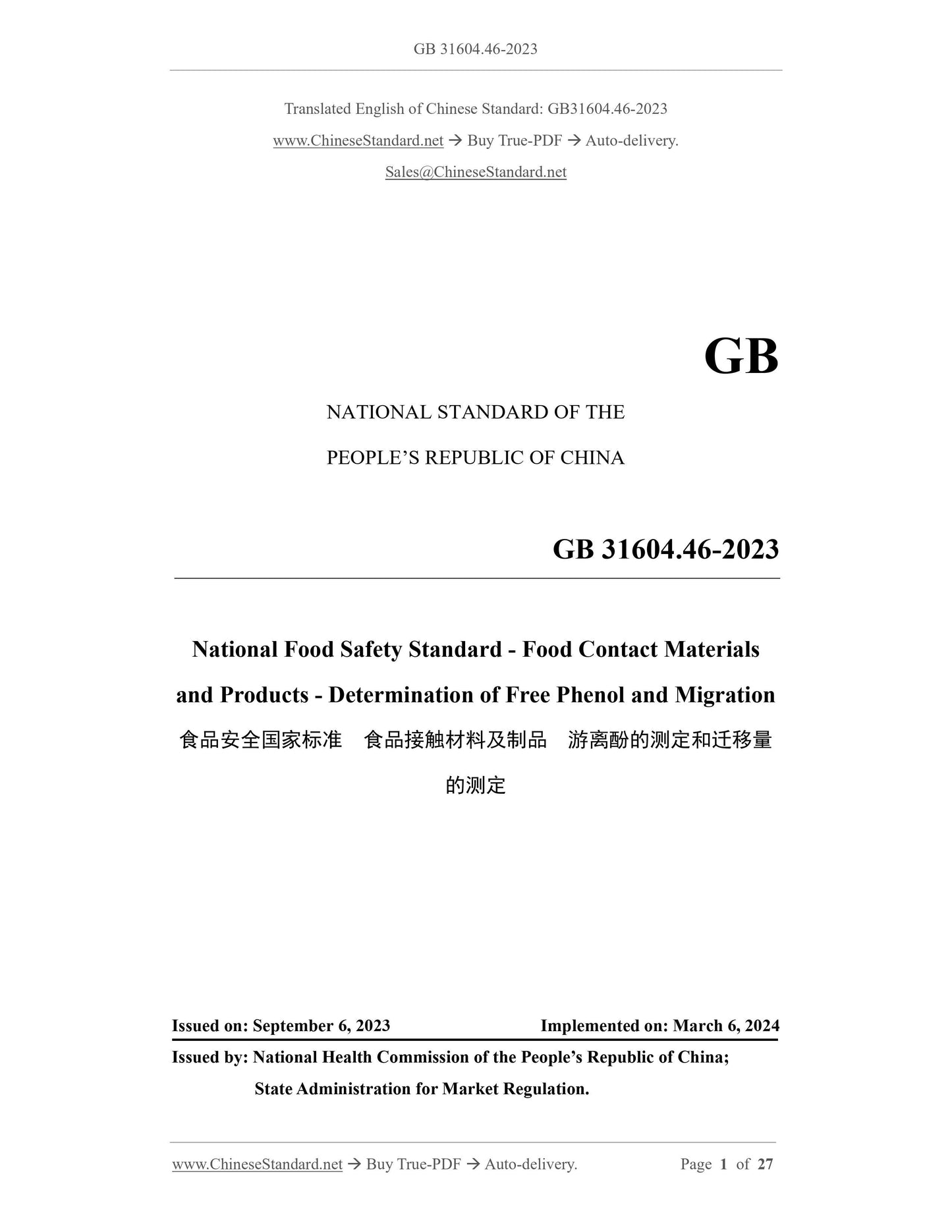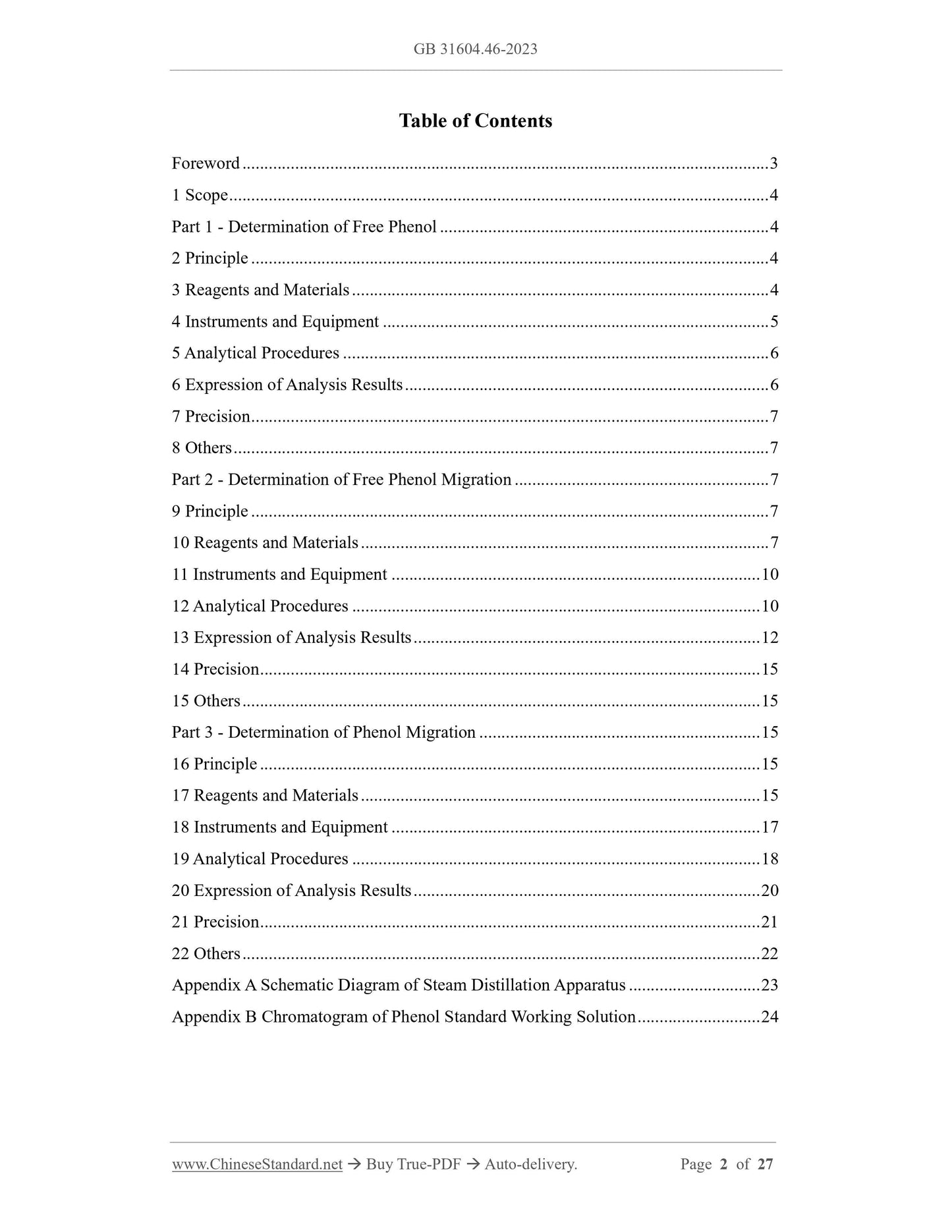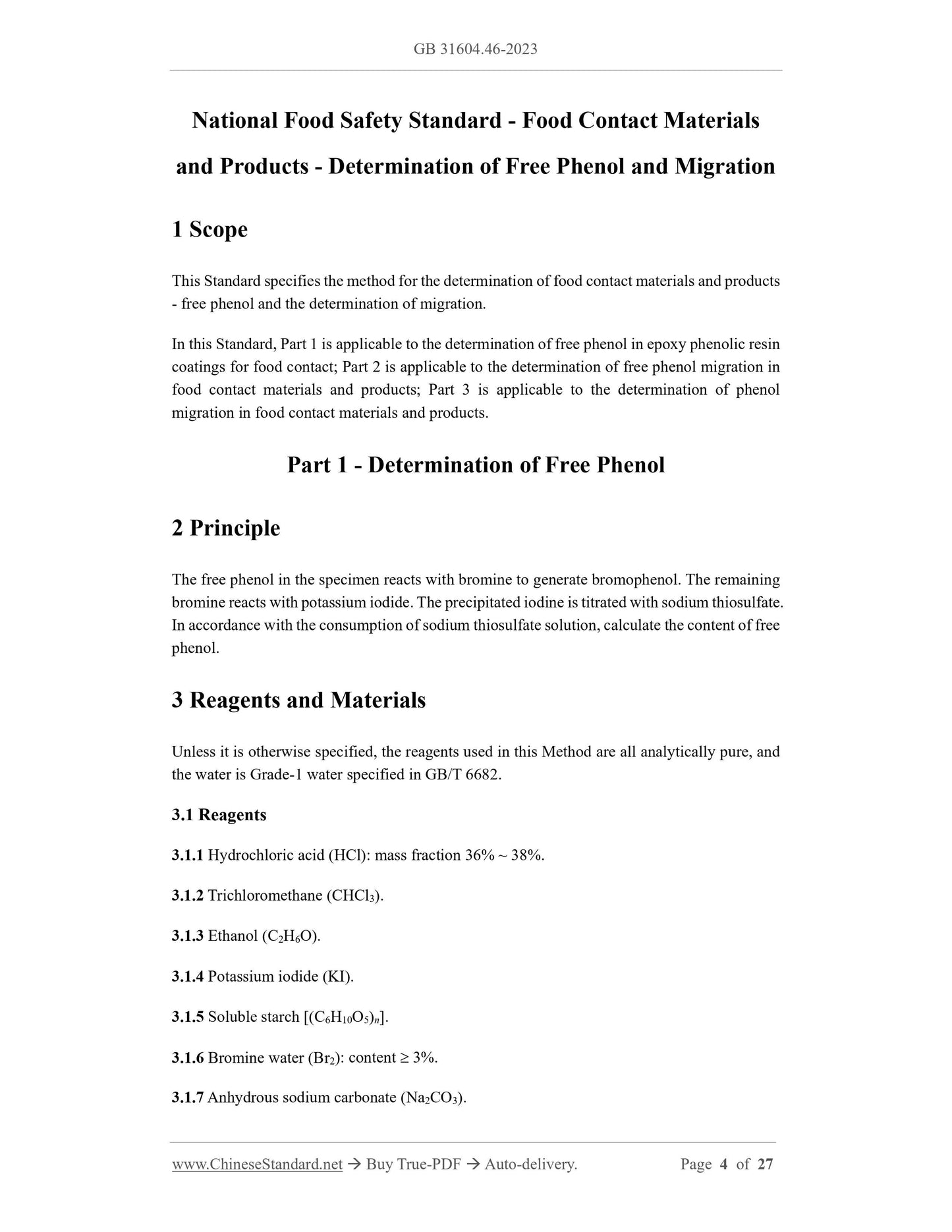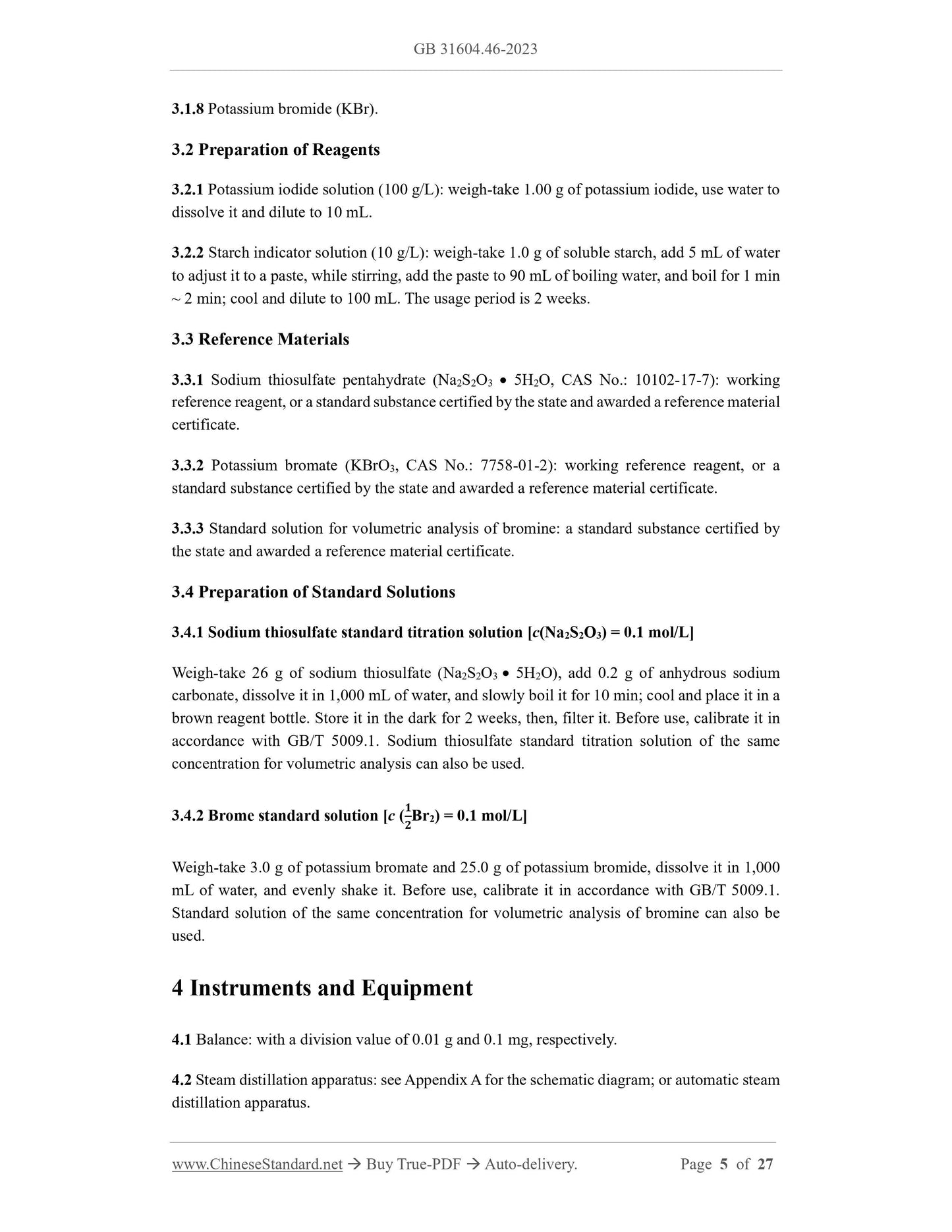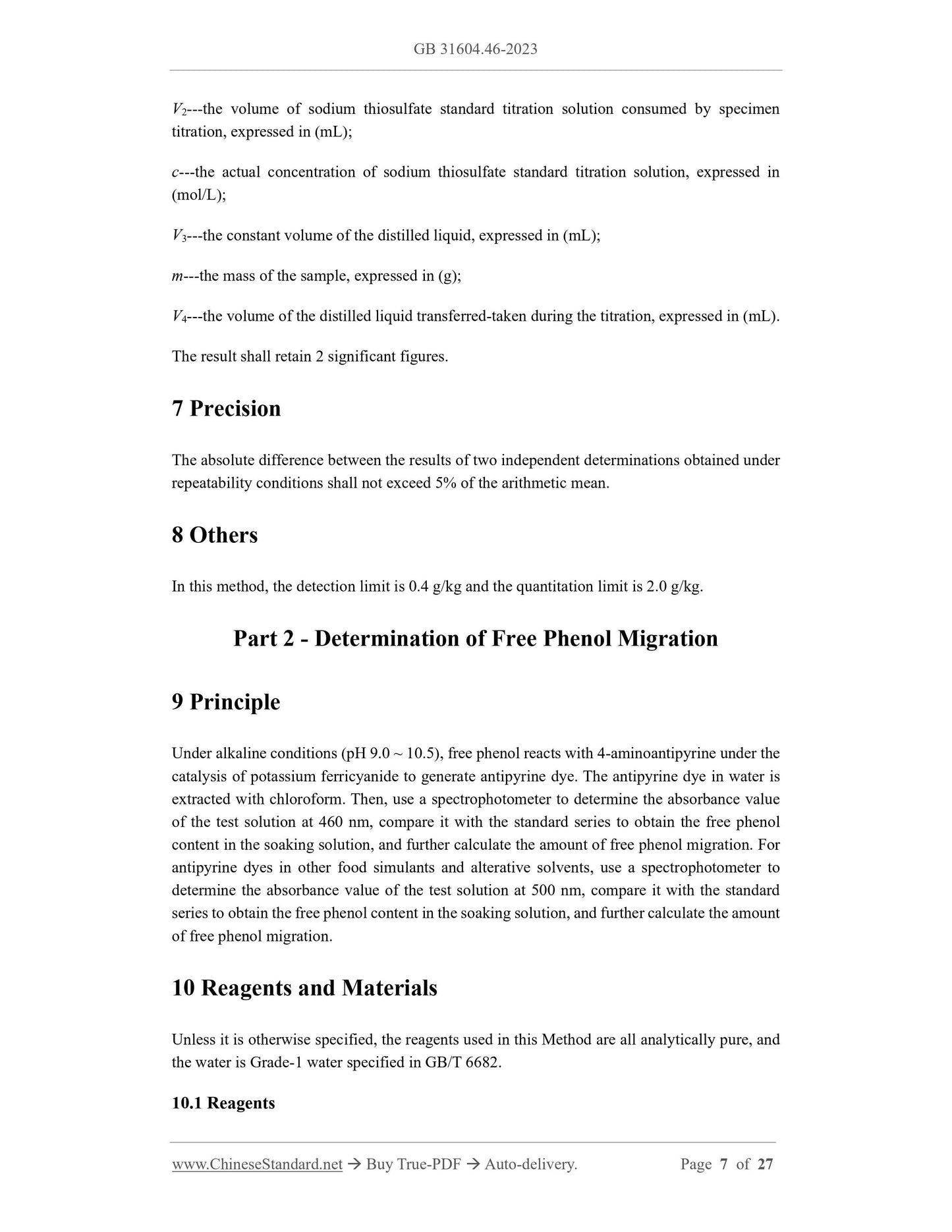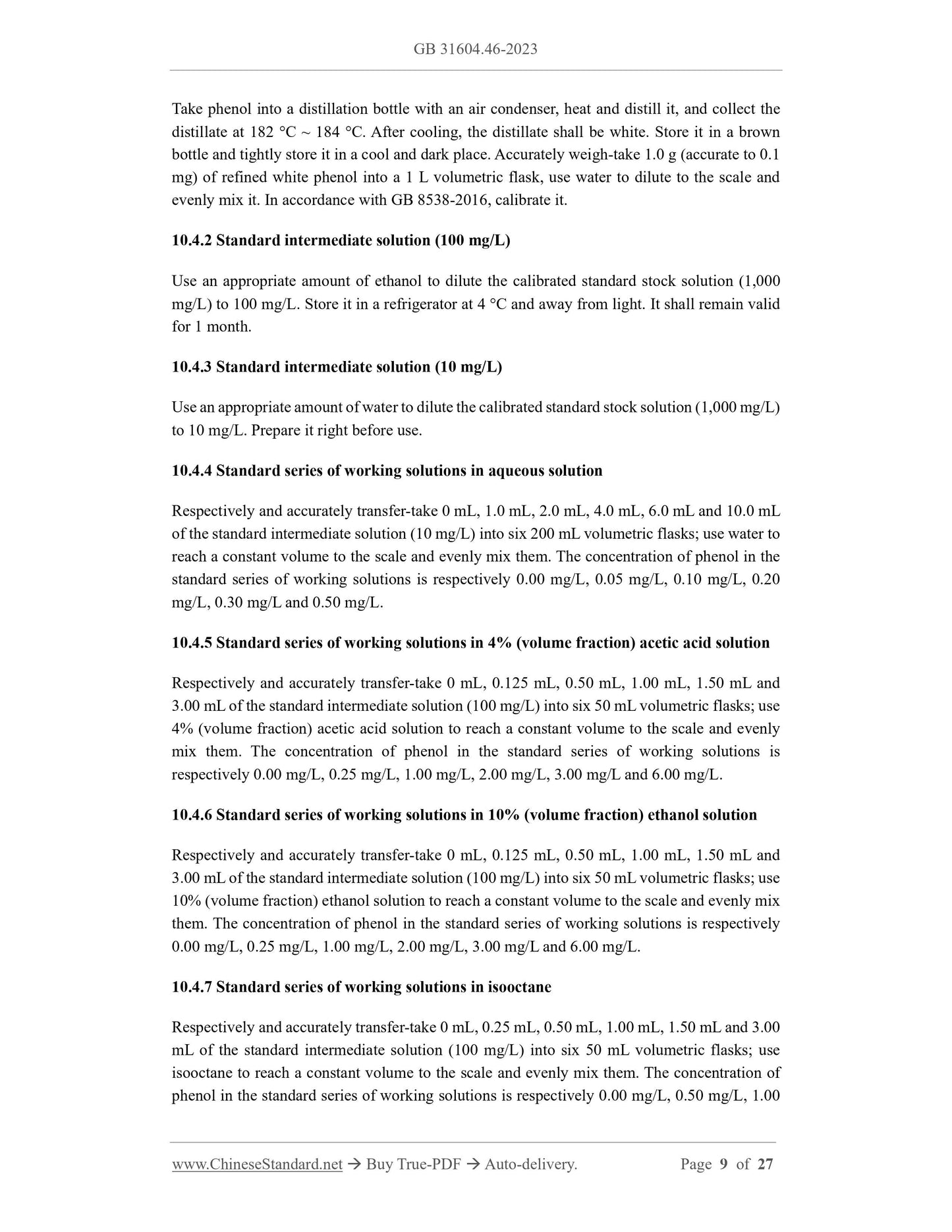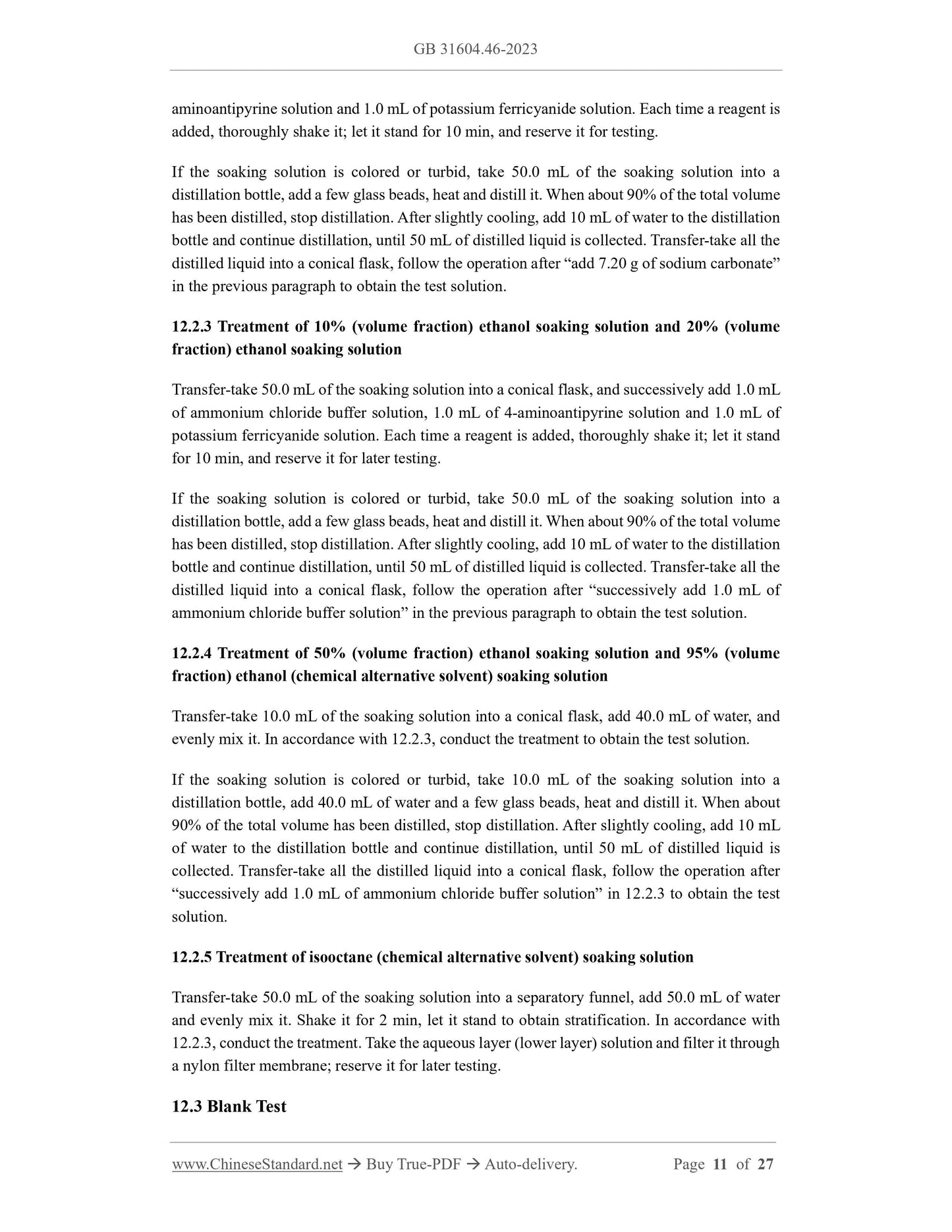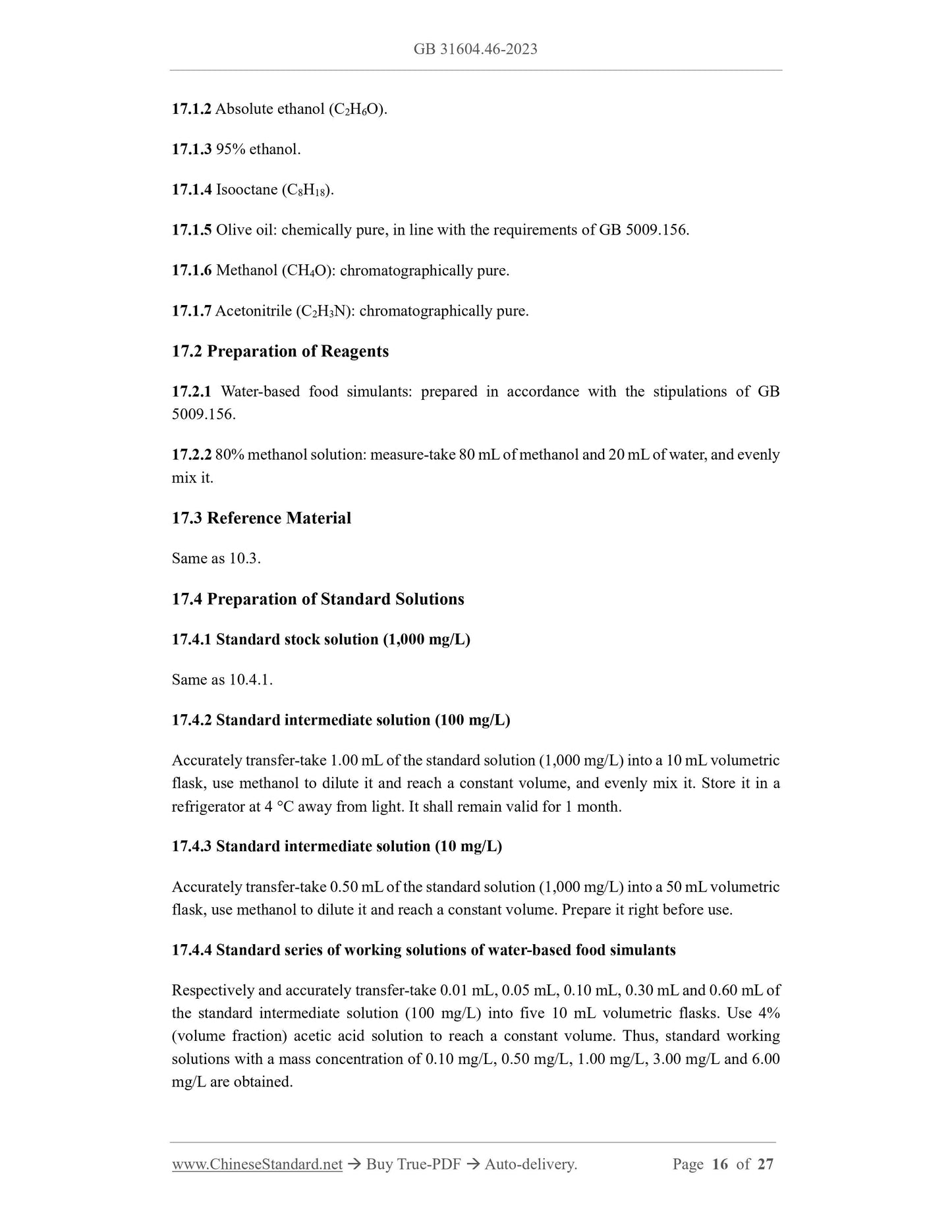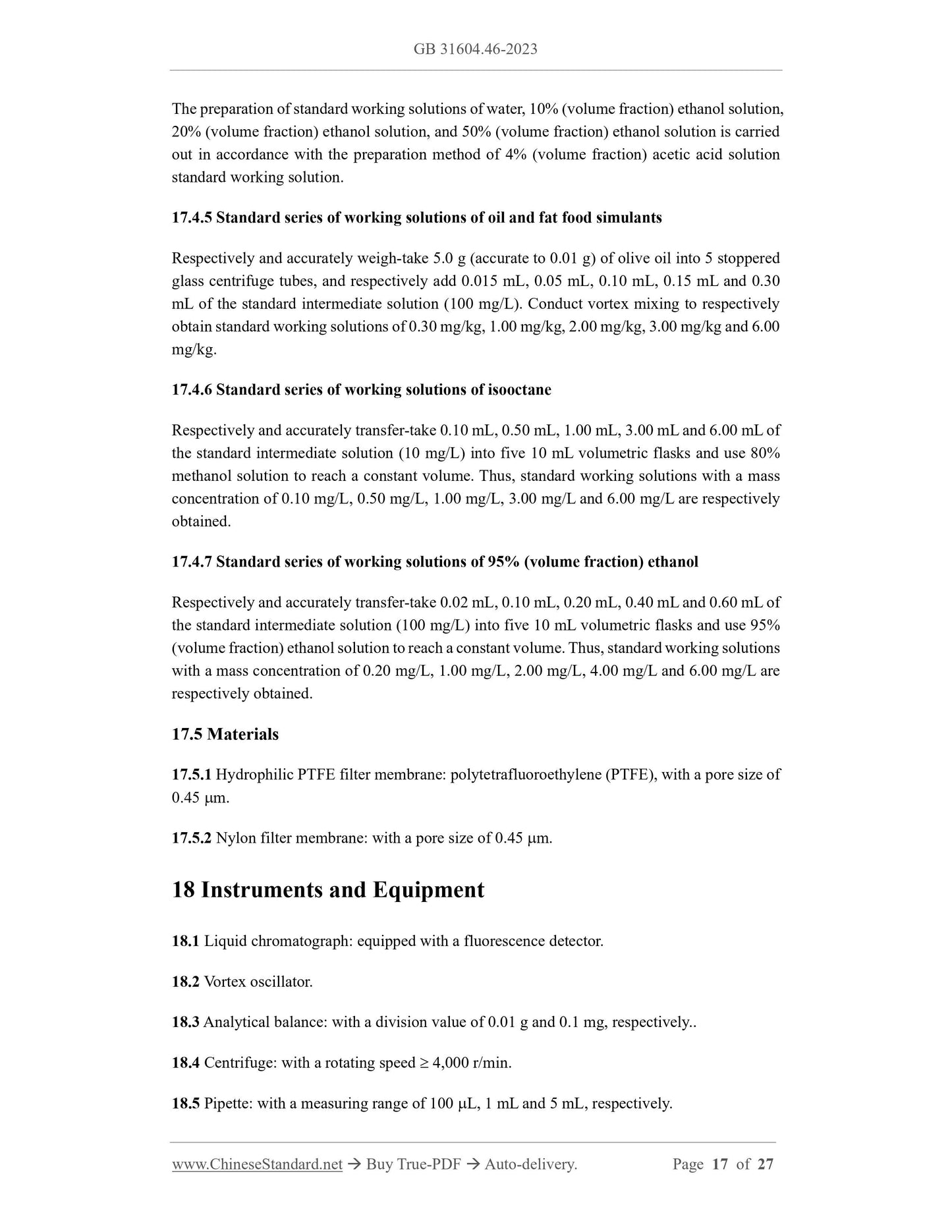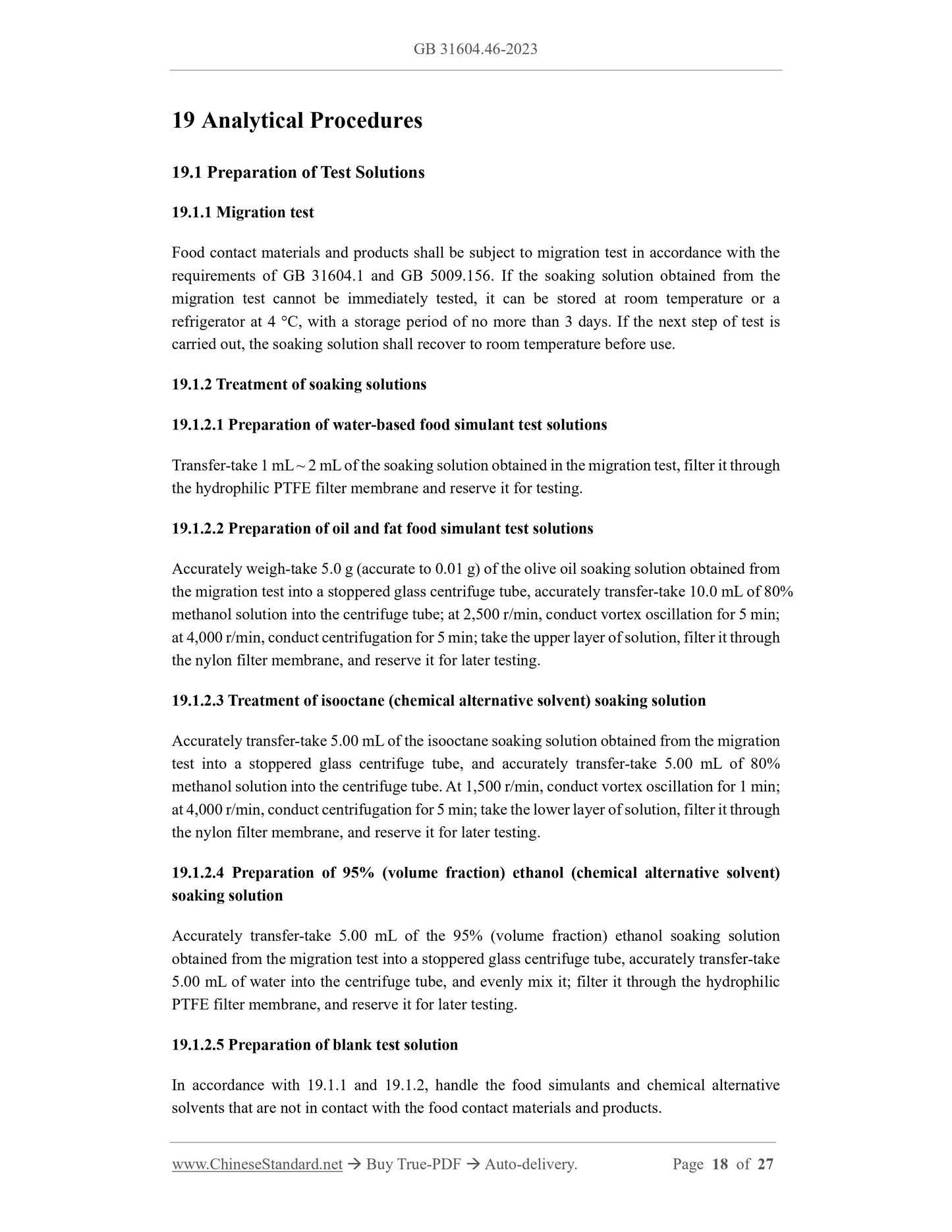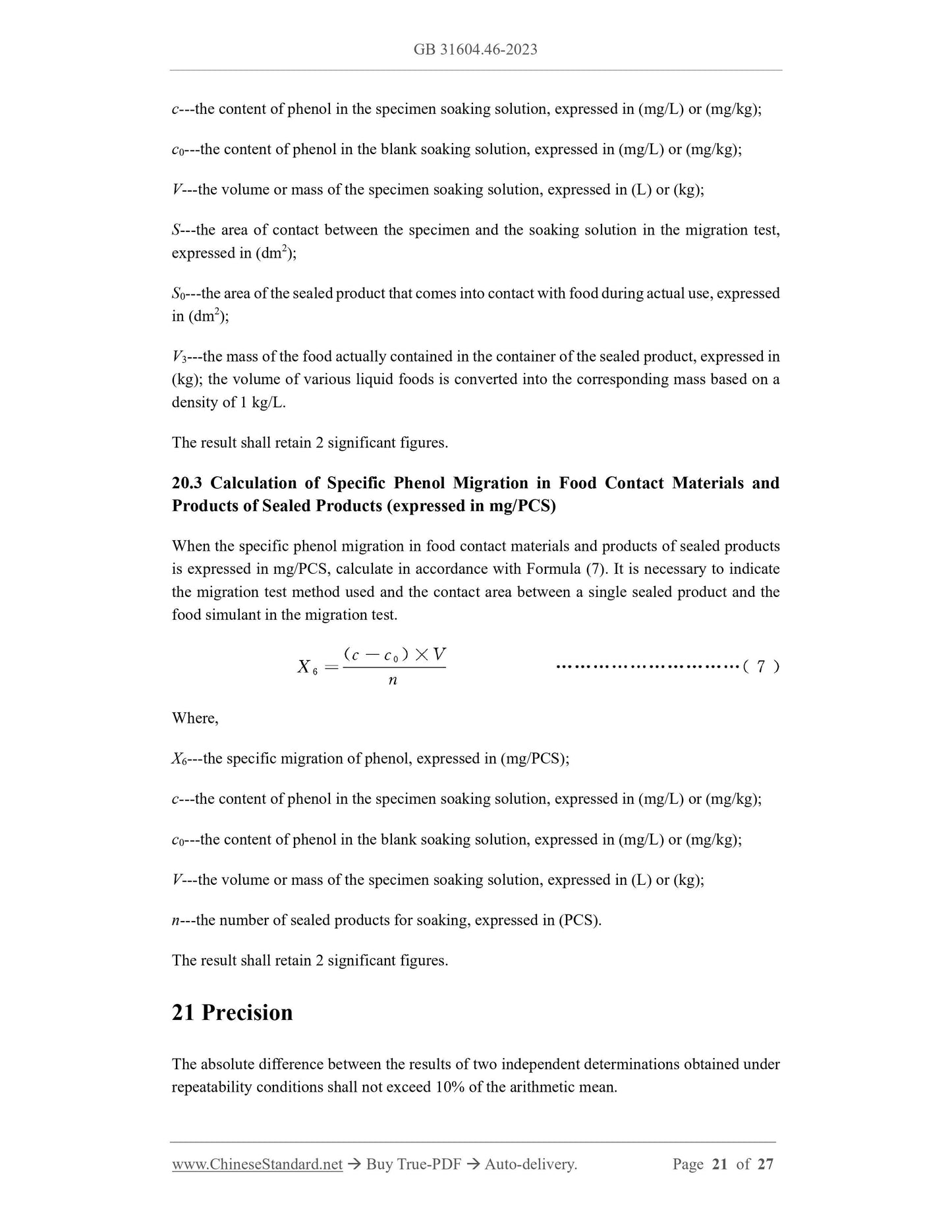PayPal, credit cards. Download editable-PDF and invoice in 1 second!
GB 31604.46-2023 English PDF (GB31604.46-2023)
GB 31604.46-2023 English PDF (GB31604.46-2023)
Precio habitual
$335.00 USD
Precio habitual
Precio de oferta
$335.00 USD
Precio unitario
/
por
Los gastos de envío se calculan en la pantalla de pago.
No se pudo cargar la disponibilidad de retiro
Delivery: 3 seconds. Download true-PDF + Invoice.
Get QUOTATION in 1-minute: Click GB 31604.46-2023
Historical versions: GB 31604.46-2023
Preview True-PDF (Reload/Scroll if blank)
GB 31604.46-2023: National food safety standard - Food contact materials and products - Determination of free phenol and migration
GB 31604.46-2023
GB
NATIONAL STANDARD OF THE
PEOPLE’S REPUBLIC OF CHINA
National Food Safety Standard - Food Contact Materials
and Products - Determination of Free Phenol and Migration
ISSUED ON: SEPTEMBER 6, 2023
IMPLEMENTED ON: MARCH 6, 2024
Issued by: National Health Commission of the People’s Republic of China;
State Administration for Market Regulation.
Table of Contents
Foreword ... 3
1 Scope ... 4
Part 1 - Determination of Free Phenol ... 4
2 Principle ... 4
3 Reagents and Materials ... 4
4 Instruments and Equipment ... 5
5 Analytical Procedures ... 6
6 Expression of Analysis Results ... 6
7 Precision ... 7
8 Others ... 7
Part 2 - Determination of Free Phenol Migration ... 7
9 Principle ... 7
10 Reagents and Materials ... 7
11 Instruments and Equipment ... 10
12 Analytical Procedures ... 10
13 Expression of Analysis Results ... 12
14 Precision ... 15
15 Others ... 15
Part 3 - Determination of Phenol Migration ... 15
16 Principle ... 15
17 Reagents and Materials ... 15
18 Instruments and Equipment ... 17
19 Analytical Procedures ... 18
20 Expression of Analysis Results ... 20
21 Precision ... 21
22 Others ... 22
Appendix A Schematic Diagram of Steam Distillation Apparatus ... 23
Appendix B Chromatogram of Phenol Standard Working Solution ... 24
National Food Safety Standard - Food Contact Materials
and Products - Determination of Free Phenol and Migration
1 Scope
This Standard specifies the method for the determination of food contact materials and products
- free phenol and the determination of migration.
In this Standard, Part 1 is applicable to the determination of free phenol in epoxy phenolic resin
coatings for food contact; Part 2 is applicable to the determination of free phenol migration in
food contact materials and products; Part 3 is applicable to the determination of phenol
migration in food contact materials and products.
Part 1 - Determination of Free Phenol
2 Principle
The free phenol in the specimen reacts with bromine to generate bromophenol. The remaining
bromine reacts with potassium iodide. The precipitated iodine is titrated with sodium thiosulfate.
In accordance with the consumption of sodium thiosulfate solution, calculate the content of free
phenol.
3 Reagents and Materials
Unless it is otherwise specified, the reagents used in this Method are all analytically pure, and
the water is Grade-1 water specified in GB/T 6682.
3.1 Reagents
3.1.1 Hydrochloric acid (HCl): mass fraction 36% ~ 38%.
3.1.2 Trichloromethane (CHCl3).
3.1.3 Ethanol (C2H6O).
3.1.4 Potassium iodide (KI).
3.1.5 Soluble starch [(C6H10O5)n].
3.1.6 Bromine water (Br2): content 3%.
3.1.7 Anhydrous sodium carbonate (Na2CO3).
3.1.8 Potassium bromide (KBr).
3.2 Preparation of Reagents
3.2.1 Potassium iodide solution (100 g/L): weigh-take 1.00 g of potassium iodide, use water to
dissolve it and dilute to 10 mL.
3.2.2 Starch indicator solution (10 g/L): weigh-take 1.0 g of soluble starch, add 5 mL of water
to adjust it to a paste, while stirring, add the paste to 90 mL of boiling water, and boil for 1 min
~ 2 min; cool and dilute to 100 mL. The usage period is 2 weeks.
3.3 Reference Materials
3.3.1 Sodium thiosulfate pentahydrate (Na2S2O3 5H2O, CAS No.: 10102-17-7): working
reference reagent, or a standard substance certified by the state and awarded a reference material
certificate.
3.3.2 Potassium bromate (KBrO3, CAS No.: 7758-01-2): working reference reagent, or a
standard substance certified by the state and awarded a reference material certificate.
3.3.3 Standard solution for volumetric analysis of bromine: a standard substance certified by
the state and awarded a reference material certificate.
3.4 Preparation of Standard Solutions
3.4.1 Sodium thiosulfate standard titration solution [c(Na2S2O3) = 0.1 mol/L]
Weigh-take 26 g of sodium thiosulfate (Na2S2O3 5H2O), add 0.2 g of anhydrous sodium
carbonate, dissolve it in 1,000 mL of water, and slowly boil it for 10 min; cool and place it in a
brown reagent bottle. Store it in the dark for 2 weeks, then, filter it. Before use, calibrate it in
accordance with GB/T 5009.1. Sodium thiosulfate standard titration solution of the same
concentration for volumetric analysis can also be used.
3.4.2 Brome standard solution [c (𝟏𝟐Br2) = 0.1 mol/L]
Weigh-take 3.0 g of potassium bromate and 25.0 g of potassium bromide, dissolve it in 1,000
mL of water, and evenly shake it. Before use, calibrate it in accordance with GB/T 5009.1.
Standard solution of the same concentration for volumetric analysis of bromine can also be
used.
4 Instruments and Equipment
4.1 Balance: with a division value of 0.01 g and 0.1 mg, respectively.
4.2 Steam distillation apparatus: see Appendix A for the schematic diagram; or automatic steam
distillation apparatus.
V2---the volume of sodium thiosulfate standard titration solution consumed by specimen
titration, expressed in (mL);
c---the actual concentration of sodium thiosulfate standard titration solution, expressed in
(mol/L);
V3---the constant volume of the distilled liquid, expressed in (mL);
m---the mass of the sample, expressed in (g);
V4---the volume of the distilled liquid transferred-taken during the titration, expressed in (mL).
The result shall retain 2 significant figures.
7 Precision
The absolute difference between the results of two independent determinations obtained under
repeatability conditions shall not exceed 5% of the arithmetic mean.
8 Others
In this method, the detection limit is 0.4 g/kg and the quantitation limit is 2.0 g/kg.
Part 2 - Determination of Free Phenol Migration
9 Principle
Under alkaline conditions (pH 9.0 ~ 10.5), free phenol reacts with 4-aminoantipyrine under the
catalysis of potassium ferricyanide to generate antipyrine dye. The antipyrine dye in water is
extracted with chloroform. Then, use a spectrophotometer to determine the absorbance value
of the test solution at 460 nm, compare it with the standard series to obtain the free phenol
content in the soaking solution, and further calculate the amount of free phenol migration. For
antipyrine dyes in other food simulants and alterative solvents, use a spectrophotometer to
determine the absorbance value of the test solution at 500 nm, compare it with the standard
series to obtain the free phenol content in the soaking solution, and further calculate the amount
of free phenol migration.
10 Reagents and Materials
Unless it is otherwise specified, the reagents used in this Method are all analytically pure, and
the water is Grade-1 water specified in GB/T 6682.
10.1 Reagents
Take phenol into a distillation bottle with an air condenser, heat and distill it, and collect the
distillate at 182 C ~ 184 C. After cooling, the distillate shall be white. Store it in a brown
bottle and tightly store it in a cool and dark place. Accurately weigh-take 1.0 g (accurate to 0.1
mg) of refined white phenol into a 1 L volumetric flask, use water to dilute to the scale and
evenly mix it. In accordance with GB 8538-2016, calibrate it.
10.4.2 Standard intermediate solution (100 mg/L)
Use an appropriate amount of ethanol to dilute the calibrated standard stock solution (1,000
mg/L) to 100 mg/L. Store it in a refrigerator at 4 C and away from light. It shall remain valid
for 1 month.
10.4.3 Standard intermediate solution (10 mg/L)
Use an appropriate amount of water to dilu...
Get QUOTATION in 1-minute: Click GB 31604.46-2023
Historical versions: GB 31604.46-2023
Preview True-PDF (Reload/Scroll if blank)
GB 31604.46-2023: National food safety standard - Food contact materials and products - Determination of free phenol and migration
GB 31604.46-2023
GB
NATIONAL STANDARD OF THE
PEOPLE’S REPUBLIC OF CHINA
National Food Safety Standard - Food Contact Materials
and Products - Determination of Free Phenol and Migration
ISSUED ON: SEPTEMBER 6, 2023
IMPLEMENTED ON: MARCH 6, 2024
Issued by: National Health Commission of the People’s Republic of China;
State Administration for Market Regulation.
Table of Contents
Foreword ... 3
1 Scope ... 4
Part 1 - Determination of Free Phenol ... 4
2 Principle ... 4
3 Reagents and Materials ... 4
4 Instruments and Equipment ... 5
5 Analytical Procedures ... 6
6 Expression of Analysis Results ... 6
7 Precision ... 7
8 Others ... 7
Part 2 - Determination of Free Phenol Migration ... 7
9 Principle ... 7
10 Reagents and Materials ... 7
11 Instruments and Equipment ... 10
12 Analytical Procedures ... 10
13 Expression of Analysis Results ... 12
14 Precision ... 15
15 Others ... 15
Part 3 - Determination of Phenol Migration ... 15
16 Principle ... 15
17 Reagents and Materials ... 15
18 Instruments and Equipment ... 17
19 Analytical Procedures ... 18
20 Expression of Analysis Results ... 20
21 Precision ... 21
22 Others ... 22
Appendix A Schematic Diagram of Steam Distillation Apparatus ... 23
Appendix B Chromatogram of Phenol Standard Working Solution ... 24
National Food Safety Standard - Food Contact Materials
and Products - Determination of Free Phenol and Migration
1 Scope
This Standard specifies the method for the determination of food contact materials and products
- free phenol and the determination of migration.
In this Standard, Part 1 is applicable to the determination of free phenol in epoxy phenolic resin
coatings for food contact; Part 2 is applicable to the determination of free phenol migration in
food contact materials and products; Part 3 is applicable to the determination of phenol
migration in food contact materials and products.
Part 1 - Determination of Free Phenol
2 Principle
The free phenol in the specimen reacts with bromine to generate bromophenol. The remaining
bromine reacts with potassium iodide. The precipitated iodine is titrated with sodium thiosulfate.
In accordance with the consumption of sodium thiosulfate solution, calculate the content of free
phenol.
3 Reagents and Materials
Unless it is otherwise specified, the reagents used in this Method are all analytically pure, and
the water is Grade-1 water specified in GB/T 6682.
3.1 Reagents
3.1.1 Hydrochloric acid (HCl): mass fraction 36% ~ 38%.
3.1.2 Trichloromethane (CHCl3).
3.1.3 Ethanol (C2H6O).
3.1.4 Potassium iodide (KI).
3.1.5 Soluble starch [(C6H10O5)n].
3.1.6 Bromine water (Br2): content 3%.
3.1.7 Anhydrous sodium carbonate (Na2CO3).
3.1.8 Potassium bromide (KBr).
3.2 Preparation of Reagents
3.2.1 Potassium iodide solution (100 g/L): weigh-take 1.00 g of potassium iodide, use water to
dissolve it and dilute to 10 mL.
3.2.2 Starch indicator solution (10 g/L): weigh-take 1.0 g of soluble starch, add 5 mL of water
to adjust it to a paste, while stirring, add the paste to 90 mL of boiling water, and boil for 1 min
~ 2 min; cool and dilute to 100 mL. The usage period is 2 weeks.
3.3 Reference Materials
3.3.1 Sodium thiosulfate pentahydrate (Na2S2O3 5H2O, CAS No.: 10102-17-7): working
reference reagent, or a standard substance certified by the state and awarded a reference material
certificate.
3.3.2 Potassium bromate (KBrO3, CAS No.: 7758-01-2): working reference reagent, or a
standard substance certified by the state and awarded a reference material certificate.
3.3.3 Standard solution for volumetric analysis of bromine: a standard substance certified by
the state and awarded a reference material certificate.
3.4 Preparation of Standard Solutions
3.4.1 Sodium thiosulfate standard titration solution [c(Na2S2O3) = 0.1 mol/L]
Weigh-take 26 g of sodium thiosulfate (Na2S2O3 5H2O), add 0.2 g of anhydrous sodium
carbonate, dissolve it in 1,000 mL of water, and slowly boil it for 10 min; cool and place it in a
brown reagent bottle. Store it in the dark for 2 weeks, then, filter it. Before use, calibrate it in
accordance with GB/T 5009.1. Sodium thiosulfate standard titration solution of the same
concentration for volumetric analysis can also be used.
3.4.2 Brome standard solution [c (𝟏𝟐Br2) = 0.1 mol/L]
Weigh-take 3.0 g of potassium bromate and 25.0 g of potassium bromide, dissolve it in 1,000
mL of water, and evenly shake it. Before use, calibrate it in accordance with GB/T 5009.1.
Standard solution of the same concentration for volumetric analysis of bromine can also be
used.
4 Instruments and Equipment
4.1 Balance: with a division value of 0.01 g and 0.1 mg, respectively.
4.2 Steam distillation apparatus: see Appendix A for the schematic diagram; or automatic steam
distillation apparatus.
V2---the volume of sodium thiosulfate standard titration solution consumed by specimen
titration, expressed in (mL);
c---the actual concentration of sodium thiosulfate standard titration solution, expressed in
(mol/L);
V3---the constant volume of the distilled liquid, expressed in (mL);
m---the mass of the sample, expressed in (g);
V4---the volume of the distilled liquid transferred-taken during the titration, expressed in (mL).
The result shall retain 2 significant figures.
7 Precision
The absolute difference between the results of two independent determinations obtained under
repeatability conditions shall not exceed 5% of the arithmetic mean.
8 Others
In this method, the detection limit is 0.4 g/kg and the quantitation limit is 2.0 g/kg.
Part 2 - Determination of Free Phenol Migration
9 Principle
Under alkaline conditions (pH 9.0 ~ 10.5), free phenol reacts with 4-aminoantipyrine under the
catalysis of potassium ferricyanide to generate antipyrine dye. The antipyrine dye in water is
extracted with chloroform. Then, use a spectrophotometer to determine the absorbance value
of the test solution at 460 nm, compare it with the standard series to obtain the free phenol
content in the soaking solution, and further calculate the amount of free phenol migration. For
antipyrine dyes in other food simulants and alterative solvents, use a spectrophotometer to
determine the absorbance value of the test solution at 500 nm, compare it with the standard
series to obtain the free phenol content in the soaking solution, and further calculate the amount
of free phenol migration.
10 Reagents and Materials
Unless it is otherwise specified, the reagents used in this Method are all analytically pure, and
the water is Grade-1 water specified in GB/T 6682.
10.1 Reagents
Take phenol into a distillation bottle with an air condenser, heat and distill it, and collect the
distillate at 182 C ~ 184 C. After cooling, the distillate shall be white. Store it in a brown
bottle and tightly store it in a cool and dark place. Accurately weigh-take 1.0 g (accurate to 0.1
mg) of refined white phenol into a 1 L volumetric flask, use water to dilute to the scale and
evenly mix it. In accordance with GB 8538-2016, calibrate it.
10.4.2 Standard intermediate solution (100 mg/L)
Use an appropriate amount of ethanol to dilute the calibrated standard stock solution (1,000
mg/L) to 100 mg/L. Store it in a refrigerator at 4 C and away from light. It shall remain valid
for 1 month.
10.4.3 Standard intermediate solution (10 mg/L)
Use an appropriate amount of water to dilu...
Share
